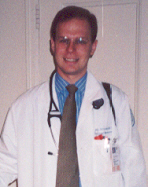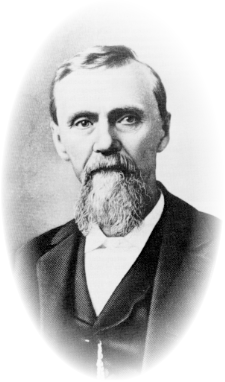|
What is a
Doctor of
Osteopathic Medicine (D.O.)? |
 If you're like most people, you've been going to a doctor since you were
born, and perhaps were not aware whether you were seeing a D.O. (osteopathic physician) or
an M.D. (allopathic physician). You may not even be aware that these are the only two
types of complete physicians in the United States.
If you're like most people, you've been going to a doctor since you were
born, and perhaps were not aware whether you were seeing a D.O. (osteopathic physician) or
an M.D. (allopathic physician). You may not even be aware that these are the only two
types of complete physicians in the United States.The
fact is, both D.O.s and M.D.s are complete physicians. They are both licensed by state and
specialty boards to perform surgery and prescribe medication. Is there any difference
between these two types of physicians? Yes. And no.
|
Additional
information may be found in these American Osteopathic Association Web pages:
Osteopathic Medicine
Osteopathic Medical
Education
OMT: Hands-On Care
The History of Osteopathic Medicine Virtual Museum
|
D.O.s and M.D.s are alike in many ways:
- Applicants to both D.O. and M.D. colleges typically have a
four-year undergraduate degree with an emphasis on science courses.
- Both D.O.s and M.D.s complete four years of basic medical
education.
- After medical school, both D.O.s and M.D.s can choose to
practice in a specialty area of medicine such as psychiatry, surgery, or obstetrics.
They both complete a residency program, which takes typically two to six years of
additional training.
- Both D.O.s and M.D.s must pass comparable state licensing
examinations.
- D.O.s and M.D.s both practice in fully accredited and
licensed hospitals and medical centers.
- D.O.s comprise a separate, yet equal branch of American
medical care. Together D.O.s and M.D.s enhance the state of health care available in
America.
- However, it's the ways that D.O.s and M.D.s are different
that can bring an extra dimension to your family's health care.
D.O.s bring something extra
to medicine:
- D.O.s practice a "whole person" approach to
medicine. Instead of just treating specific symptoms or illnesses, they regard your body
as an integrated whole, based on the osteopathic philosphy of
Andrew Taylor Still.
- Osteopathic physicians focus on preventive healthcare.
- D.O.s receive extra training in the musculoskeletal system -
your body's interconnected system of nerves, muscles and bones that make up two-thirds of
its body mass. This training provides osteopathic physicians with a better understanding
of the ways that an injury or illness in one part of your body can affect another. It
gives D.O.s a therapeutic and diagnostic advantage over those who do not receive
additional specialized training.
- Osteopathic manipulative treatment (OMT) is incorporated in
the training and practice of osteopathic physicians. OMT allows physicians to use their
hands to diagnose injury and illness and to encourage your body's natural tendency toward
good health. By combining all other medical procedures with OMT, D.O.s offer their
patients the most comprehensive care available in medicine today.
100 Years of Unique Care
 Osteopathic medicine is a
unique form of American medical care that was developed in 1874 by frontier doctor Andrew
Taylor Still. Dr. Still was dissatisfied with the effectiveness of 19th Century medicine.
He believed that many of the medications of his day were useless or even harmful. Dr.
Still was one of the first in his time to study the attributes of good health so that he
could better understand the process of disease. Osteopathic medicine is a
unique form of American medical care that was developed in 1874 by frontier doctor Andrew
Taylor Still. Dr. Still was dissatisfied with the effectiveness of 19th Century medicine.
He believed that many of the medications of his day were useless or even harmful. Dr.
Still was one of the first in his time to study the attributes of good health so that he
could better understand the process of disease.
In response Dr. Still founded a philosophy of medicine
based on ideas that date back to Hippocrates, the Father of Medicine. The philosophy
focuses on the unity of all body parts. He identified the musculoskeletal system as a key
element of health. He recognized the body's ability to
heal itself and stressed preventive medicine, eating properly and keeping fit.
Dr. Still pioneered the concept of
"wellness" 100 years ago. In today's terms, personal health risks - such as
smoking, high blood pressure, excessive cholesterol levels, stress and other lifestyle
factors - are evaluated for each individual. In coordination with appropriate medical
treatment, the osteopathic physician acts as a teacher to help patients take more
responsibility for their own well-being and change unhealthy patterns.
Today osteopathic physicians continue to be on the
cutting edge of modern medicine. D.O.s are able to combine today's awesome medical
technology with the tools of their ears, to listen carefully to their
patients; their eyes, to see their patients as whole persons; and their hands,
to diagnose and treat injury and illness.
|
|
![[my picture]](images/drosenthal.jpg) What is a D.O.?
What is a D.O.?
![[my picture]](images/drosenthal.jpg) What is a D.O.?
What is a D.O.?

![]() Return to David Rosenthal's Home Page
Return to David Rosenthal's Home Page